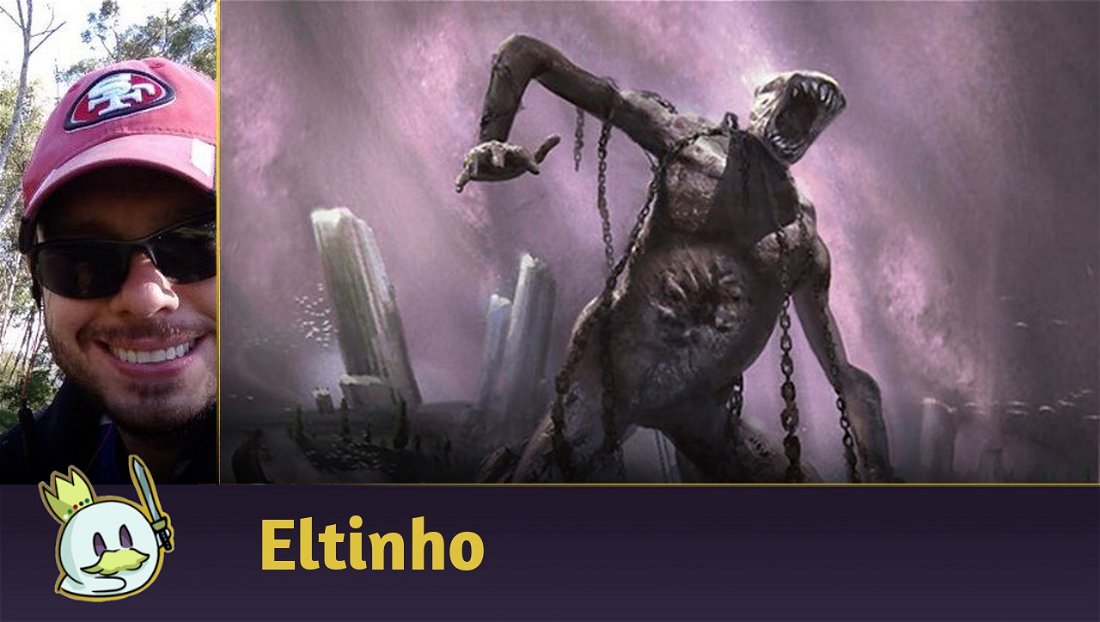Introduction
When I was analyzing all possible commanders from Murders at Karlov Manor, I stumbled upon Yarus, Roar of the Old Gods. This is an interesting card with many effects, but what stood out the most to me was his "mini Reanimate" effect.
So, I tested his potential and eventually had enough to write an entire deck tech around him!
Commander and Mechanic
When you take a closer look at Yarus, you'll notice that he definitely stands out as a commander because of how much he actually does. After all, for 4 mana, we have a 4/4 that gives Haste to our other creatures, draws us cards when one or more face-down creatures deal damage, and also returns them to the board if they die while face-down.
Ad

We can use many sacrifice tools in this deck, and also many creatures with Disguise, Morph, and Manifest in Gruul 

Yarus, Roar of the Old Gods Decklist and Deck Strategy
We also play many damage sources we can use as alternative win conditions, even if they are a bit slow as they deal very little damage. The fact he brings back creatures means we'll bring back powerful creatures and also use their effects if they were face-down; they'll trigger again thanks to his "mini Reanimate" effect.
With all of this in mind, let's see the list.
Accelerators and Ramp

Above, you'll notice we play some mana rocks to be faster throughout the game: Sol Ring, Gruul Signet, and Arcane Signet.
For ramp, we play the 2-costs Rampant Growth, Farseek, Nature's Lore, and Three Visits, and Stomping Ground, Cinder Glade, and Wooded Ridgeline to get our lands. As 3-costs, we use the popular Kodama's Reach and Cultivate.

Then, we use Birds of Paradise and Tin Street Gossip as our mana dorks. Tin Street Gossip in particular works really well in this list because it creates 2 mana for face-down creatures.
Flourishing Bloom-Kin is also one of our great ramp sources, considering we'll cheat out its Disguise cost with our commander, and it'll be like a Cultivate, almost.
To discount our costs, we use Goblin Anarchomancer and Obscuring Aether. If our opponents target it and try to destroy them, we can answer by turning it face-down, resolving its death, and returning it to the board with Yarus. The various possibilities our commander gives us are just fascinating.

Face-Down Creatures

Starting with some honorable mentions, we have Branch of Vitu-Ghazi and Zoetic Cavern. These lands can go in face-down and then return as lands thanks to Yarus.
We also have some essential creatures for this strategy, like Experiment Twelve, which buffs our other creatures, and Pyrotechnic Performer, which deals significant amounts of damage to our opponents.
Ad
If these two are in play, they can deal up to 26 damage to all our opponents when we turn a Krosan Cloudscraper face up, for instance. Salt Road Ambushers is similar to Experiment Twelve, but it only gives us two +1/+1 counters when we turn a creature face-up.

Of course, we added some removals, more precisely creatures that have built-in removals in their "face-up" effects.
Vengeful Creeper, Nantuko Vigilante, and Ainok Survivalist remove artifacts and enchantments that may become problematic down the line. Akroma, Angel of Fury, Krosan Colossus, and Primal Whisperer are our main sources of damage. Hooded Hydra and Printlifter Ooze will potentially create several tokens on our board and widen it even more. I'll highlight Printlifter Ooze, which triggers any time we turn a creature face-up.

Finally, we have some creatures whose effects trigger when we turn them face-up. Den Protector will get us some resources from a graveyard like an Eternal Witness.
Boltbender can redirect spells or abilities; for instance, we can use it to make ourselves the target of a Walk the Aeons and thus play an extra turn. Root Elemental puts a creature directly on our battlefield, more precisely one of the several useful ones we'll mention soon.
Deathmist Raptor is one of the most useful cards in this deck, considering we can sacrifice it multiple times when we turn our permanents face up, and then return it from our graveyard face-down. It is an excellent engine for this strategy.

Ashcloud Phoenix is also critical; it is one of the main pieces in a combo in this deck. To make it work, we need to have more life than our opponents, though.
Nervous Gardener will always give us a land because of its ability, and Greenbelt Radical gives us the evasion we need to deal damage with our other creatures and consequently draw cards because of Yarus.

Sacrifice Sources and Interaction with Face-Down Cards

To play the combo we mentioned before, we need a sacrifice source like Blasting Station. With Yarus and Ashcloud Phoenix in play, we need to sacrifice it so it returns to our board, and then turn it face-up. Then, we need to sacrifice it again so Ashcloud Phoenix returns face-down, and repeat this process. We'll always untap Blasting Station when we return our Ashcloud Phoenix, and thus hit our opponents' life points with both Blasting Station and Ashcloud Phoenix.
Ad

This combo also works with Goblin Bombardment, Altar of Dementia, and Ashnod's Altar. However, with the Altars, we need more life than our opponents so we don't die with them in this process, as the Phoenix deals damage to all players simultaneously.
We can also use Evolutionary Leap to sacrifice our cards, but it doesn't give us an infinite loop like the ones we listed before. It's still great, though, considering we'll create value from its sacrifice effect by adding creature cards to our hand.

There are many other interesting possibilities we can use in this deck, and thus use strategies like casting face-down creatures for free. We need cards that discount the cost of creature spells, like these three: Nylea, Keen-Eyed, Obscuring Aether, and Dream Chisel. With these 3 in play, we'll be able to play cards with Disguise, Morph, or Megamorph for 0 mana. If we have any of these three in play with an Ugin, the Ineffable, we also discount its cost to 0, considering Ugin discounts the cost of all colorless cards by 2.

Scroll of Fate also cheats out the cost of a face-down creature by manifesting it. Its effect is similar to Panoptic Projektor, but we don't need to turn the card face-up. What really matters is that it can be useful as a finisher because of the interaction we listed before with Experiment Twelve, Krosan Cloudscraper, and Pyrotechnic Performer.
With these three in play, Yarus, a sacrifice source, and Panoptic Projektor, we just need to sacrifice Krosan Cloudscraper face-down. By turning it face-up, we'll trigger Experiment Twelve twice, and first gain 13 +1/+1 counters, then 26 +1/+1 counters because of Panoptic Projektor. After this ability resolves, Pyrotechnic Performer will deal 52 damage twice to all opponents, which is a lethal interaction in this deck, apart from the Phoenix combo.

Ugin's Mastery is a 2-for-1 card, as it manifests the top of our deck any time we cast a colorless creature. The downside is that we can't manipulate the top of our deck, but, considering we only have 14 non-permanent cards, we can afford to manifest them with no stress.
Rageform also manifests the top of our deck, and, if you do decide to use it, it is interesting to turn your creatures face-up through other means, like Expose the Culprit. And, speaking of 2-for-1 cards, Hide in Plain Sight is also a great option for this strategy.

Temur War Shaman works like a combat-based removal, and thus allows us to control the battlefield better. Whisperwood Elemental and Yedora, Grave Gardener give us some safety, considering they fill our board again thanks to manifest or because they return our cards face-down as lands so we can ramp, respectively.
Keep in mind that we don't have to use Yedora's effect, which means we can choose what we want to do whenever a creature dies while Yedora is in play. Finally, we added Goblin Maskmaker to discount the cost of our face-down cards, and Trail of Mystery to filter the lands in our deck. It also buffs our creatures when we turn them face up.
Ad

Utility and Similar

Then, we added many utility cards for all situations. To finish the game with the Phoenix combo or just hit our opponents' lives harder, we added Impact Tremors and Purphoros, God of the Forge to deal damage whenever a creature enters the battlefield under our control.
To get back the resources we lost from our graveyard, we added Eternal Witness and Timeless Witness. As target removal, Beast Within and Chaos Warp are enough, considering this deck's strategy and speed. To hit more targets, we have Decimate and Blasphemous Act as global removals.

Beast Whisperer is great when we manage to stick it on the board at any point of the match because our deck is entirely based on creatures. Rishkar's Expertise also draws us many cards, not to mention the free cast we get after we draw these cards.
And, to finish, we play Rhythm of the Wild to deal with control decks, and Heroic Intervention to defend ourselves whenever an opponent targets our permanents, or just protect ourselves from global removals.
Budget Yarus, Roar of the Old Gods List
This budget version isn't all that different. We kept most of the cards in the original list and managed to lower its cost by almost half. We even got to keep the combo and the lethal damage interactions, so we changed very little, and the result is very similar to the strategies we presented in this deck tech.
Final Words
I was impressed by how Yarus can wreak havoc with so many cards. Most interactions involve 4 or 5 cards, but this deck doesn't seem to stand out as we play it; then, when our opponents least expect it, we'll simply win the game out of nowhere and surprise everyone.
Personally, I don't really enjoy this type of mechanic, but I saw so much of it that I was quite curious and wanted to find out more about this charismatic Centaur.
Did you like this list? Would you add more combos? Remove them altogether? Share your thoughts with us down below in our comment section!
See you next time!










— Comments0
Be the first to comment